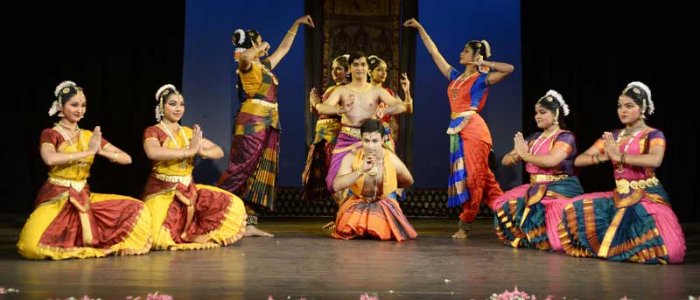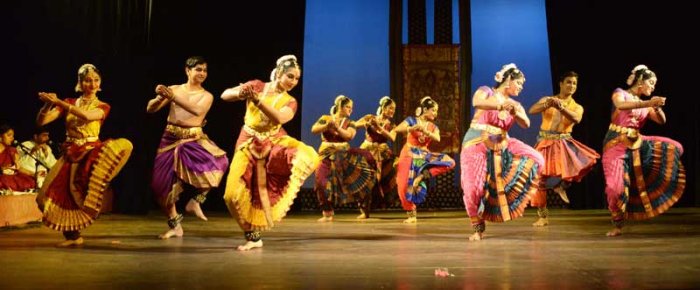 |
 |
Bhadrachala Ramadas: A devotional journey - Satish Suri e-mail: satishism@yahoo.co.in Photos: Shandilya Srivatsa March 6, 2016 The introductory remarks by Poornima Gururaja, outlining the many facets of the celebrated composer Bhadrachala Ramadas (originally named Gopanna), traces his journey from a Tahsildar who after collecting the revenues,thought it would be put to better use for constructing a temple. Subsequently, he was found guilty of embezzlement and sentenced to be imprisoned for twelve years. His steadfast devotion did not diminish and through his compositions pleaded with the Lord to relieve him of his suffering. It is said that Rama and Lakshmana appeared before Tanashah, the Qutub Shahi ruler and repaid the dues in the form of two gold coins and obtained the release of Ramadas. The king recognized the greatness of Ramadas and he was provided land around Bhadrachalam to continue his dedicated services. His kirtans have been popularized and have a wide ranging appeal.  In the narrative presented through song and dance at the Seva Sadan in Bangalore on 12th February, the students of the three senior gurus Poornima Gururaja, Soundarya Srivatsa and Shakuntala Prabhat, and Devaraju (disciple of Guru Bhanumathi) performed with confidence and commendable ability. The flow of the storyline began with a pushpanjali, a composition of Dr.Balamuralikrishna, one of the many who popularized the compositions. The bhakti rasa was maintained by the chosen compositions. “Dina me sudhinamu ra, ramuni talchina dina me sudhinamu ra” outlining that the very thought of Rama is enough to make the moment auspicious. The only medicine for all troubles and travails of humanity was described in the composition “Rama jogi mandu konare.” The valour of Rama who vanquishes Ravana was eulogised in “Dasaratha Rama Govinda” and the sanchari of Gajendra Moksham made it presence in the rendition. The miracles of Rama are outlined in the composition “Charanamule nammiti” depicting Ahalya being released from her curse by the mere touch of his lotus feet. In his period of incarceration in the prison, the agony and anguish of Ramadas as he pleads with Rama to release him from his suffering are essayed through “Paluke Bangaramayane”, “Ikshavaku tilaka”, “Sitarama swamy ne chesina nerumu yemi” and “Ye tiruga nanne daya chuchedavo vina vamshottama Rama.” The tenor of sarcasm creeps into his compositions as he questions Rama about his indifference to his agony.The lord hears his pleas and obtains his release by giving Tanashah two gold coins as repayment of the debt. Still in doubt about Rama’s benevolence he pleads with Sita to assure Rama that he is the only one for him. The final composition “Takkuvemi manasu” composed by Vasudha Balakrishna in a thillana format provided a fitting finale describing Rama as Lord Vishnu who protected his devotees through the dasavataras. The dancers Anil Iyer, Chaitra Ananth, Gowri Sagar, Devaraju, Krithika Thyagarajan, Pooja Vidya Tayoor, Priyadarshini Vasudev, MV Soundarya and K Swathi did an admirable job in maintaining the flow of the narrative. The constraints of limitation of sancharis, the dominant note being bhakti did not deter the three choreographers Poornima Gururaja, Soundarya Srivatsa and Shakuntala Prabhat (all students of the late Guru Narmada) who with creative choreographic inputs and synchronised nritta segments set the performance space radiating with vibrancy, geometric patterns and the youthful dancers adding vitality to the vocabulary of movements provided the rendition with a refreshing appeal that was widely appreciated by the audience.  The music ensemble was an added asset comprising of Vasudha Balakrishna (vocals), Shakuntala Prabhat and Soundarya Srivatsa (nattuvangam), Raghunandan (flute) and S.V. Balakrishna (mridangam) provided the necessary flourish to the dancers presentation. The program conceptualised by R.K.Usha was presented under the auspices of Sadguru Thyaga Brahma Aradhana Kainkarya Trust, Bangalore. Bangalore based Satish Suri is an avid dance rasika besides being a life member of the Music and Arts Society. |